Posted by R. John Howe on 01-21-2004 05:57 PM:
Karachopf Design Komments
Dear folks –
Pat Weiler has already commented on the Karachoph Kazak
seeming designs in rugs in two of these paintings. He said:
“…Not only
are the wares similar, but the rugs are the same, too. The Karachoph Kazak at
the left of both paintings is the same, and it appears that the green-ground rug
being held up in the second painting is the same as the one to the right of the
suzani in the first painting.
This leads one to think that the rugs were from
the artist's studio and not painted from life.”
My thoughts:
I
don’t want this “easy” one to get away before I can speak to it, since it may be
one of the few pieces in Filiberto’s test challenge here to which my books will
let me speak with any intelligibility at all.
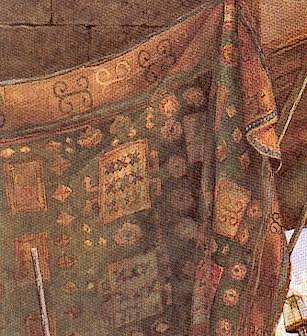
The piece used does
have lots of pretty obvious Karachoph features, but it also seem to me that the
rendering may not be quite faithful to the usages in actual Karachopf Kazaks
that are published.
Here is one of the prettiest of the published
Karachoph Kazaks from Mike Tschebull’s wonderful little catalog “Kazak.”
(Remember Mike, this is the copy I bought on Capitol Hill for $9, and for which
you offered me $12?)
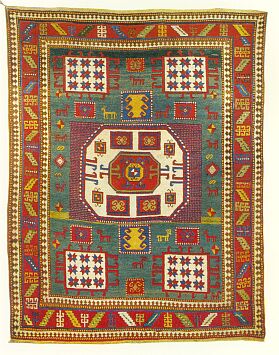
And here are three more from Ian Bennett’s book
“Caucasian.”
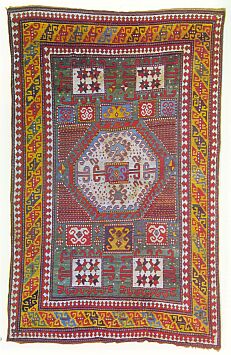
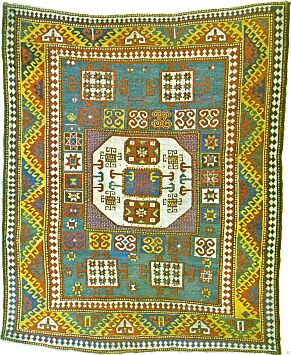
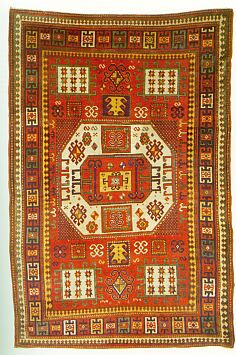
Now, the first
deviation I think I see is that the device of the main border is not quite the
device that occurs in Karachopf Kazaks as a border, although there are
some borders (see the Bennett piece immediately above) that have devices similar
to the usages in the paintings. It is oriented correctly, but still seems a
somewhat different device than that on the Bennett piece. I think that what we
have as a border in this piece is, in fact, a device that tends to occur in
cartouches and cross-panels just above or below the main medallion in the field.
More important, perhaps, is the fact that there is also something that
seems not quite right to me about the left side of the treatment of the
Karachopf in the painting. Instead of the central medallion starting up (where
is the central medallion?) there is a second set of these horizontally placed
cartouches or cross-panel devices. The center of a usual Karachopf design seems
to be missing to me.
I think this is an instance of a not quite accurate
rendition of a Karachopf design in a couple of respects. I say this while
realizing that there is a range of variation in Karachopf designs that is
considerable.
Anyone agree, or have I just added anew to the huge pile of
nits I have picked in my life to date as a "rug analyst?" 
Regards,
R. John Howe
Posted by Filiberto Boncompagni on 01-22-2004 02:48 AM:
Hi John.
Your comments on the rendering of the Karachov could lead to
a very interesting conclusion, thanks.
First, the border: although
unusual it is perfectly plausible and I can think of no reason for re-inventing
it. I had a look to the other picture, the "Carpet Bazaar, Cairo, 1887".
Unfortunately it has no enough resolution and zooming on it isn’t very useful,
but the motifs in the main border seem the same. Interestingly, though, the rug
in this picture appears to have a better secondary border system.
I did
not notice the missing center. You are right, there is something suspicious
here.
My explanation:
The painting dated 1887 was made first, as I
said in another thread. That’s why the rug border system in it looks more
plausible. The border version in the other painting is
simplified.
Robertson had used a previously made sketch portraying the
Karachov. In this sketch the visible part of the rug was quite short.
For
"artistic" reasons he needed a longer rug for is painting and not knowing how
could be the design in the hidden part (the central medallion) he simply
extrapolated it repeating the visible part.
BUT this means that Robertson
had no further access to the Karachov: the rug was "captured" in real life, not
in a studio. Possibly the rug was in Cairo at the time.
Any different
opinions?
Regards,
Filiberto
Posted by R. John Howe on 01-22-2004 04:20 AM:
Writing Too Fast
Filiberto et al –
One of the great temptations of this medium is to
write a bit too fast and then to regret later. I have to withdraw immediately my
criticism that the device used by the painter in this Karachopf is not one found
in the borders of published rugs of this type.
My error was not to look
at Schurmann, whose volume sits conveniently above my head, and who shows a
Karachopf with this device both, in the field cartouches and in the borders.
Here it is:
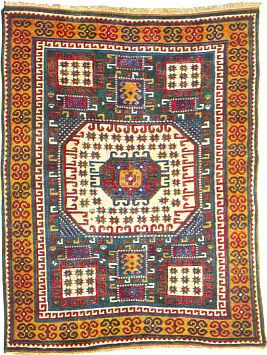
The only piece of this part of my critique that I can retain is
a suggestion that the painter has spaced these “X” forms too widely, but that
now is real quibble.
I quite like your argument suggesting why this rug
may have been done on site and not available later in the studio. Very
nice.
Regards,
R. John Howe
Posted by Filiberto Boncompagni on 01-22-2004 07:47 AM:
Well, really, thank you my dear fellow! (puff, puff)
Jolly good having
(puff) your help on that. Quite so.
Regards (puff)

Filiberto
Posted by R. John Howe on 01-22-2004 12:41 PM:
Hi Filiberto -
If it's beginning to show, perhaps I've been reading a
bit too much Kipling recently. 
Regards,
R. John Howe
Posted by Filiberto Boncompagni on 01-22-2004 12:58 PM:
No, it's me reading too much A.C. Doyle 
Regards,
Filiberto
Posted by Filiberto Boncompagni on 01-22-2004 02:02 PM:
Did you know that "A study in Scarlet" was published in 1887?








